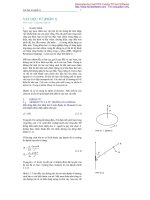Dairy Farm Energy Management Handbook phần 1 pptx
Bạn đang xem bản rút gọn của tài liệu. Xem và tải ngay bản đầy đủ của tài liệu tại đây (71.88 KB, 6 trang )
Dairy Farm Energy Management Handbook
Table of Contents
Introduction
Farm Energy Audits
Farm Wiring
Equipment Operation & Management
Scroll Compressors / Reciprocating Compressors
Milk Cooling / Refrigeration Heat Recovery / Pre-Coolers
Water Heating
Washing System
Vacuum Pumps
Livestock Water Fountains
Ventilation and Fans
Lighting Efficiently
Electric Motors
Fencers, Cow Trainers & Gates
Appendices
Farm Electrical and Safety Checklist
Equipment Maintenance Checklist
Resource Information and Background
Associations and Organizations
Web Sites
Contacts for Rewiring Programs
Publications
Glossary of Terms
References
For example, numerous equipment upgrade options exist which can be
applied in a fairly short time. Better and more efficient lighting fixtures, high
efficiency water heaters and electric motors are just a few examples of what
choices are available to you today.
Making those choices is also fairly simple because research and studies have
closely examined energy usage on farms and evaluated what changes make
the best economic sense in terms of payback.
A proactive plan to regularly check or service equipment and make necessary
repairs on a scheduled basis will more than pay for itself when compared to
having to do the same work in a crisis or hurried situation.
The general rule is that for every dollar spent on preventive maintenance, you
will save at least five dollars in subsequent expenses. (1)
Better energy management can also impact milk production in a positive way,
as well as help you increase net returns in dairying by keeping equipment
operating at optimal conditions.
Good energy management also makes sense from a safety standpoint,
especially when it involves examining and maintaining the wiring system to
keep it in top-notch condition. For example, some insurance industry reports
have shown that more than 12% of farm fire losses (property and personal
injuries) involve the electrical system.
This is why you’re strongly encouraged to take advantage of the utility’s
expertise in evaluating your existing wiring infrastructure and electrical
equipment to make sure that it’s safe, up-to-date, and operating efficiently and
properly.
In Wisconsin, all utilities offer a combination of rebates, grants and loans to
help offset the cost for rewiring agricultural facilities.
While every aspect of energy management can’t be covered here, this
handbook will attempt to highlight some important points about farm energy
audits, wiring, cooling milk and water heating, ventilation, lighting and electric
motors. They all represent key areas to consider in your quest to manage and
conserve energy.
In addition, you will also find key contact and resource information in the
appendix section at the back of this handbook, if you wish to pursue energy
topics in more detail.
Note: This Dairy Farm Energy Management Handbook was prepared by Karl Ohm, an
agricultural and natural resource journalist/photographer, based in Menomonee Falls, Wis., in
cooperation with the WDATCP and the Rural Energy Management Council (REMC).
But since each dairy farm may face different circumstances, it is very
important to start with an energy audit that can help provide a snapshot view
of your current situation.
The farm energy audit will serve as a meaningful reference point upon which
better decisions and comparisons can be made about equipment upgrades
and wiring issues and what changes may offer the quickest paybacks.
Such paybacks will obviously occur more quickly in those key areas that
normally use the most energy on your dairy farm.
On most dairy farms in Wisconsin, milk cooling
accounts for the lion’s share of electricity usage at
25%, followed by ventilation at 19%, water heating
at 18%, vacuum pumps at 17%, and lighting at
15%. Electric space heating and miscellaneous
uses accounted for another 6% of electricity usage.
(2)
Dairy farms in other states also show similar energy
demands. For example, according to the Dairy
Farm Energy Audit Summary in New York, milk
cooling, lighting, ventilation, and vacuum pumps
are the top four categories that accounted for 88% of all electrical energy
used on all of the audited farms.
Breaking this down further, milk cooling’s share totaled 25%, followed by
lighting at 24%, ventilation at 22%, and vacuum pumps at 17%. Electric water
heating (4%), manure handling (4%), feeding equipment (3%), and
miscellaneous (1%) made up the balance of 12%.
So, an energy audit is well worth the effort since experience has already
shown that dairy producers can save 10 to 40% – or more, in some cases –
by using reliable energy-efficient technology in their milking, milk cooling, and
water heating processes, according to the University of Wisconsin - Madison.
“Getting an energy audit done on your farm is an important first step to take
in developing a comprehensive energy management plan,” says Scott
Sanford, senior outreach specialist with the University of Wisconsin’s Rural
Energy Program.
An energy audit will help lead the way
to better management, and the best
place to start is to contact your power
utility or the Wisconsin Focus on
Energy program (Appendix).
The energy audit may also help
pinpoint other areas requiring attention.
For example, vacuum pumps not
maintained properly, poor lighting
conditions, or improperly sized
ventilation fans are just a few factors
that can influence cow comfort and
behavior and ultimately milk production.
So, while these costs don’t directly
show up as line items on the utility bill, sooner or later they will creep in and
shrink your margins.
Also, many energy management recommendations made by these audits are
often linked to rebates or low interest loan programs within the Wisconsin
Focus on Energy program or your local utility, according to Rich Hasselman,
an energy consultant with GDS Associates, of Madison, a firm that helps
perform audits for this program.
The proper sizing of barn fans and well-
functioning louvers may also be included in a
comprehensive farm energy audit plan.
Photo: Karl Ohm
Depending on the utility, grants ranging from $4,000 up to $10,000 and low
interest loans are available along with different matching requirements for
customers.
The farm rewiring programs offered by utilities are definitely helping to
enhance the power quality on many farms. The program has also raised the
bar for everybody in terms of following the National Electric Code standards.
With any new wiring system, it’s important to keep at least four basic ideas in
mind, according to the National Food and Energy Council:
• Safety: Fully complying with and adhering to National and State
Electrical Codes are your best aids in developing a wiring system that
will operate efficiently and safely for many years.
• Adequately sized: The wiring system must have enough circuits and
outlets of the correct size and type and consist of the proper materials to
prevent premature corrosion or overload. Also, give careful thought
about what equipment, including the location and power demands, will
be served by specific circuits and outlets. This information is also
valuable when working with your utility to ensure that the transformer
serving your farm is sized correctly.
• Expandable: Working with a qualified electrician and your utility on
what things to consider for future additions or expansions can save a lot
of headaches and unnecessary costs in the long run. This step
becomes very important when specifying service entrance panels, sizing
conductors, and selecting wiring methods.
• Efficient: A well-planned wiring system doesn’t cut corners and allows
sufficient planning time to work with your qualified electrician and/or
utility. An efficient system minimizes power losses from voltage drops by
using adequately sized conductors and uses quality components.
Spending the necessary upfront time to plan an
efficient system is a wise investment that can
generate significant dividends in terms of
reliability and farm productivity.
It’s also important to underscore that deriving the
safety and energy-saving benefits from today’s
more efficient equipment depends greatly on a well-designed and up-to-date
wiring system.
In contrast, trying to operate new equipment with an undersized and grossly
outdated wiring and component system can be very dangerous.
Editor’s note: You’re encouraged to contact your local utility and/or the
Wisconsin Focus on Energy Program for more information on Farmstead
Rewiring programs. Specific contact information relating to rewiring program
grants can be found in the appendix section of this handbook (Appendix).









